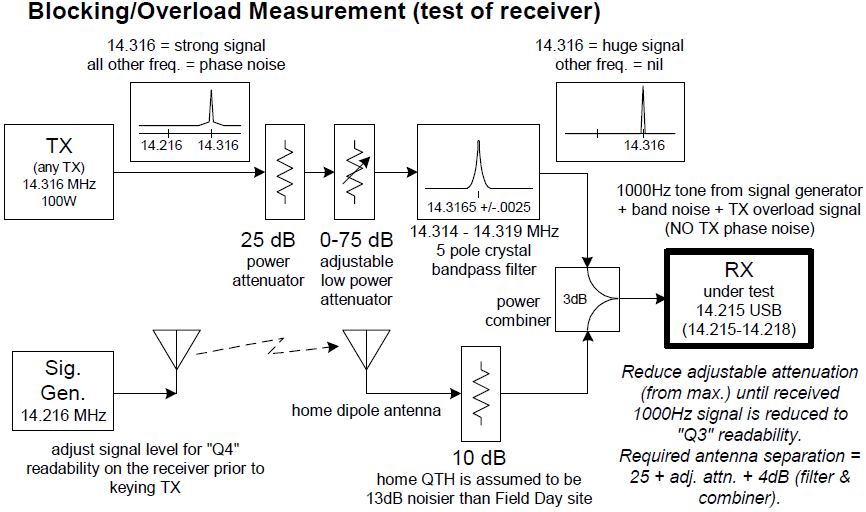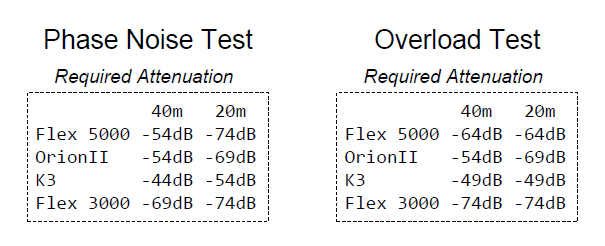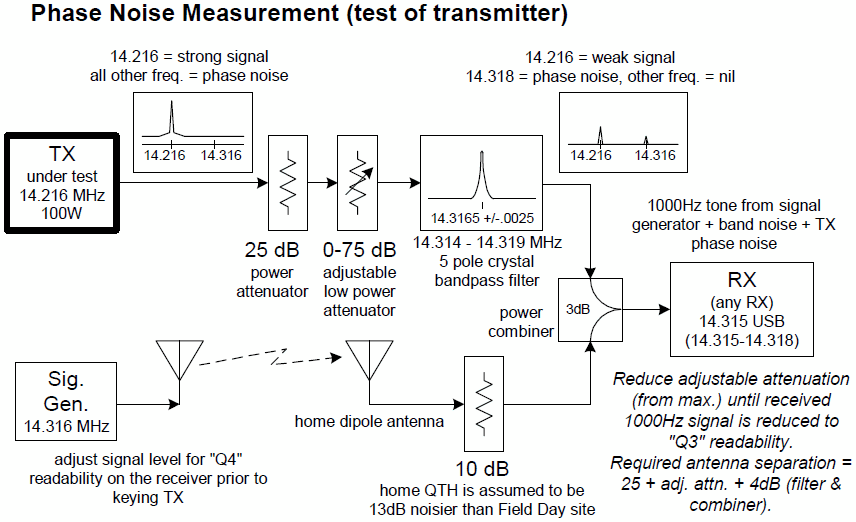Field Day Interference
Phase Noise / Overload Tests
Page content last updated Jun. 27, 2012 (orig. content Sep. 14, 2011)
Copyright © 2011-2012 Larry Benko, W0QE
Operating Field Day with multiple transmitters involves coordination among the transmitters and antennas to minimize interference. Simple solutions involve using the full 1000' circle allowed for the antennas, dedicating a station for a single band, and/or using single band filters such as the W3NQN filters which are in both the transmit and receive signal paths. With the limited propagation due to the sunspots there is often a desire to operate on 40m or 20m, CW and SSB at the same time with 2 stations as these bands are the most productive. However issues of interference quickly become apparent with two 100 watt transmitters offset by 80 to 100 KHz and having antennas separated only a few hundred feet. Many Field Day sites and groups are unwilling or unable to use the maximum 1000' circle and building filters that can handle 100W (low passband loss) while producing 20+dB loss only 80 KHz away are not feasable. Antenna isolations (on the same band) can be as little as 20dB (no work) or as much as 75dB (considerable work if even possible). The question becomes, what antenna isolation is necessary for a particular set of radios to operate interference free?
There are two primary types of interference: Phase noise and Overload
Phase noise is a transmitter only issue and all transmitters have phase noise. When a transmitter operates on a particular frequency it actually transmits some small power on all frequencies. This non-harmonically related power is known as phase noise and the other radio may hear this noise at the receive frequency above any band noise rendering reception impossible or limited.
Blocking or Overload is a receiver only issue. All receivers suffer from overload which occurs when an extremely strong off frequency signal is delivered to the receiver reducing the sensitivity or producing artifacts rendering reception impossible or limited.
The problem is to determine what antenna isolation (attenuation) is needed for a particular choice of radios to operate without interference.
Phase noise is a transmitter only issue and all transmitters have phase noise. When a transmitter operates on a particular frequency it actually transmits some small power on all frequencies. This non-harmonically related power is known as phase noise and the other radio may hear this noise at the receive frequency above any band noise rendering reception impossible or limited.
Blocking or Overload is a receiver only issue. All receivers suffer from overload which occurs when an extremely strong off frequency signal is delivered to the receiver reducing the sensitivity or producing artifacts rendering reception impossible or limited.
The problem is to determine what antenna isolation (attenuation) is needed for a particular choice of radios to operate without interference.
Types of Interference
Tests are needed to separate phase noise interference from blocking interference in order to be able to determine the required antenna isolation without needing 2 radios of the model you wish to test. The equipment I used consisted of a signal generator, several RF attenuators including one capable of 100W, an HF low power combiner, and 2 crystal bandpass filters. The crystal filter designs are in the "Projects" section or click here.
The crystal filters can handle +20dBm signals in both the pass and stop bands.
20m 5 pole crystal filter:
Passband: 14.314 - 14.319 MHz (~1.6dB insertion loss) SWR < 1.5:1
Stopband: more than -90dB for f < 14.285 MHz & f > 14.334 MHz
40m 5 pole crystal filter:
Passband: 7.160 - 7.163 MHz (~1.6dB insertion loss) SWR < 1.5:1
Stopband: more than -85dB for f < 7.125 MHz & f > 7.168MHz
I decided to make the criteria be an 80KHz TX/RX separation on 40m and a 100kHz separation on 20m with 100W transmitters. Note: The phase noise of most transmitters is NOT reduced when the output power is turned down. Also the Field Day site is defined as having a noise level that is 13dB lower than the noise at my QTH.
The crystal filters can handle +20dBm signals in both the pass and stop bands.
20m 5 pole crystal filter:
Passband: 14.314 - 14.319 MHz (~1.6dB insertion loss) SWR < 1.5:1
Stopband: more than -90dB for f < 14.285 MHz & f > 14.334 MHz
40m 5 pole crystal filter:
Passband: 7.160 - 7.163 MHz (~1.6dB insertion loss) SWR < 1.5:1
Stopband: more than -85dB for f < 7.125 MHz & f > 7.168MHz
I decided to make the criteria be an 80KHz TX/RX separation on 40m and a 100kHz separation on 20m with 100W transmitters. Note: The phase noise of most transmitters is NOT reduced when the output power is turned down. Also the Field Day site is defined as having a noise level that is 13dB lower than the noise at my QTH.
Test Setup
Test Results
Attenuation steps were in 5dB increments since signal readability from Q4 to Q3 is somewhat subjective.
Please observe closely how the "spectrum analyzer" depictions show how the crystal filters do their magic allowing the tests to separate phase noise interference from overload. The following figures show the 20m tests but a similar set of tests was done on 40m with an 80kHz frequency spacing. The actual tests were done in Sep. 2009. The test setups and most of this page are in a pdf file for better printing by clicking here.
These tests are not to be taken as an endorsement or criticism of any particular radio and were done with radios that were available. Thanks to N0QO and NC0B for providing the radios. The results do however show that the reputation of the Elecraft K3 for having a tough receiver and a transmitter with low phase noise is indeed true.



Field Day 2012 Measurements (Update Jun. 27, 2012)
ARRL Field Day 2012 consisted of two Elecraft K3 transceivers with dipole antennas at special event callsign W0C in the mountains of Jefferson County Colorado. The above data shows that an antenna isolation of 49dB on 40m and 54dB on 20m is needed to be able to operate simultaneously on both CW and SSB in the same band without either phase noise or overload interference. The antennas consisted of a band switchable flat top horizontal dipole 30' above the ground and a fan dipole 46' above the ground with the legs pointed downward at a 20 degree angle. The dipole centers were 265' apart and they were basically aligned end to end with about a 10' offset due to the trees and terrain. EZNEC modelling predicted antenna isolations of 47.5dB on 40m and 55.4dB on 20m. Both these isolations were very close to the isolations needed based on my tests but fit the Field Day site. Measurements on the erected antennas with a calibrated RF power meter showed isolations of 46.8dB on 40m and 54.3dB on 20m. These numbers are VERY close to the values predicted by EZNEC using poor rocky mountainous ground (.002S/m, 13). During Field Day we experienced no interference when operating simultaneously on 40m CW and SSB or simultaneously on 20m CW and SSB. Bottom line is that Field Day without interference is very enjoyable and EZNEC modelling produced an extremely good estimate of the antenna isolations.
